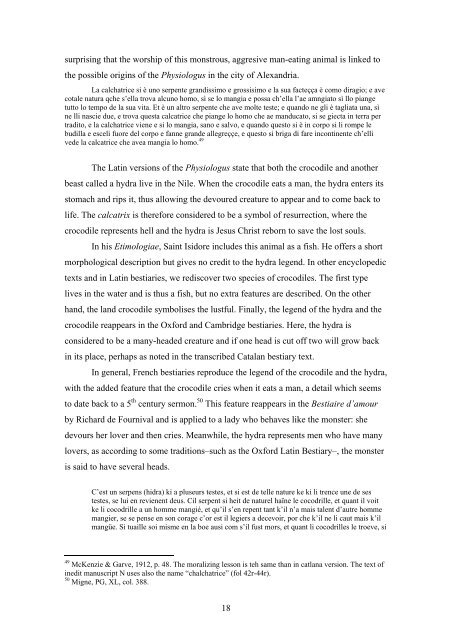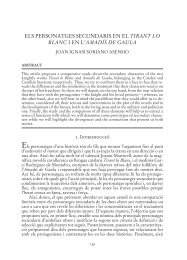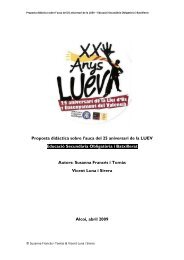Aquatic animals in the Catalan Bestiari - Institut Interuniversitari de ...
Aquatic animals in the Catalan Bestiari - Institut Interuniversitari de ...
Aquatic animals in the Catalan Bestiari - Institut Interuniversitari de ...
You also want an ePaper? Increase the reach of your titles
YUMPU automatically turns print PDFs into web optimized ePapers that Google loves.
surpris<strong>in</strong>g that <strong>the</strong> worship of this monstrous, aggresive man-eat<strong>in</strong>g animal is l<strong>in</strong>ked to<br />
<strong>the</strong> possible orig<strong>in</strong>s of <strong>the</strong> Physiologus <strong>in</strong> <strong>the</strong> city of Alexandria.<br />
La calchatrice si è uno serpente grandissimo e grossisimo e la sua facteçça è como diragio; e ave<br />
cotale natura qche s’ella trova alcuno homo, sì se lo mangia e possa ch’ella l’ae amngiato sì llo piange<br />
tutto lo tempo <strong>de</strong> la sua vita. Et è un altro serpente che ave molte teste; e quando ne gli è tagliata una, sì<br />
ne lli nascie due, e trova questa calcatrice che piange lo homo che ae manducato, si se giecta <strong>in</strong> terra per<br />
tradito, e la calchatrice viene e si lo mangia, sano e salvo, e quando questo si è <strong>in</strong> corpo si li rompe le<br />
budilla e esceli fuore <strong>de</strong>l corpo e fanne gran<strong>de</strong> allegreççe, e questo si briga di fare <strong>in</strong>cont<strong>in</strong>ente ch’elli<br />
ve<strong>de</strong> la calcatrice che avea mangia lo homo. 49<br />
The Lat<strong>in</strong> versions of <strong>the</strong> Physiologus state that both <strong>the</strong> crocodile and ano<strong>the</strong>r<br />
beast called a hydra live <strong>in</strong> <strong>the</strong> Nile. When <strong>the</strong> crocodile eats a man, <strong>the</strong> hydra enters its<br />
stomach and rips it, thus allow<strong>in</strong>g <strong>the</strong> <strong>de</strong>voured creature to appear and to come back to<br />
life. The calcatrix is <strong>the</strong>refore consi<strong>de</strong>red to be a symbol of resurrection, where <strong>the</strong><br />
crocodile represents hell and <strong>the</strong> hydra is Jesus Christ reborn to save <strong>the</strong> lost souls.<br />
In his Etimologiae, Sa<strong>in</strong>t Isidore <strong>in</strong>clu<strong>de</strong>s this animal as a fish. He offers a short<br />
morphological <strong>de</strong>scription but gives no credit to <strong>the</strong> hydra legend. In o<strong>the</strong>r encyclopedic<br />
texts and <strong>in</strong> Lat<strong>in</strong> bestiaries, we rediscover two species of crocodiles. The first type<br />
lives <strong>in</strong> <strong>the</strong> water and is thus a fish, but no extra features are <strong>de</strong>scribed. On <strong>the</strong> o<strong>the</strong>r<br />
hand, <strong>the</strong> land crocodile symbolises <strong>the</strong> lustful. F<strong>in</strong>ally, <strong>the</strong> legend of <strong>the</strong> hydra and <strong>the</strong><br />
crocodile reappears <strong>in</strong> <strong>the</strong> Oxford and Cambridge bestiaries. Here, <strong>the</strong> hydra is<br />
consi<strong>de</strong>red to be a many-hea<strong>de</strong>d creature and if one head is cut off two will grow back<br />
<strong>in</strong> its place, perhaps as noted <strong>in</strong> <strong>the</strong> transcribed <strong>Catalan</strong> bestiary text.<br />
In general, French bestiaries reproduce <strong>the</strong> legend of <strong>the</strong> crocodile and <strong>the</strong> hydra,<br />
with <strong>the</strong> ad<strong>de</strong>d feature that <strong>the</strong> crocodile cries when it eats a man, a <strong>de</strong>tail which seems<br />
to date back to a 5 th century sermon. 50 This feature reappears <strong>in</strong> <strong>the</strong> Bestiaire d’amour<br />
by Richard <strong>de</strong> Fournival and is applied to a lady who behaves like <strong>the</strong> monster: she<br />
<strong>de</strong>vours her lover and <strong>the</strong>n cries. Meanwhile, <strong>the</strong> hydra represents men who have many<br />
lovers, as accord<strong>in</strong>g to some traditions–such as <strong>the</strong> Oxford Lat<strong>in</strong> Bestiary–, <strong>the</strong> monster<br />
is said to have several heads.<br />
C’est un serpens (hidra) ki a pluseurs testes, et si est <strong>de</strong> telle nature ke ki li trence une <strong>de</strong> ses<br />
testes, se lui en revienent <strong>de</strong>us. Cil serpent si heit <strong>de</strong> naturel haïne le cocodrille, et quant il voit<br />
ke li cocodrille a un homme mangié, et qu’il s’en repent tant k’il n’a mais talent d’autre homme<br />
mangier, se se pense en son corage c’or est il legiers a <strong>de</strong>cevoir, por che k’il ne li caut mais k’il<br />
mangüe. Si tuaille soi misme en la boe ausi com s’il fust mors, et quant li cocodrilles le troeve, si<br />
49 McKenzie & Garve, 1912, p. 48. The moraliz<strong>in</strong>g lesson is teh same than <strong>in</strong> catlana version. The text of<br />
<strong>in</strong>edit manuscript N uses also <strong>the</strong> name “chalchatrice” (fol 42r-44r).<br />
50 Migne, PG, XL, col. 388.<br />
18




